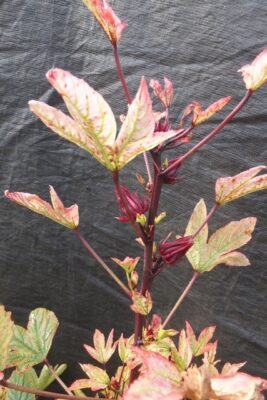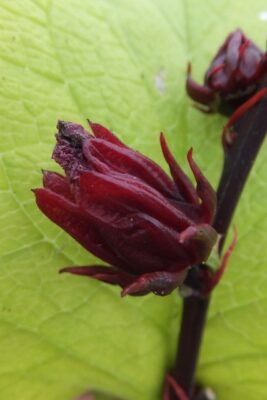
You need a warm sunny greenhouse for this tropical gem, the Roselle, which for much of the year is not the most stunning looking specimen. Though the leaves are very rich in Vitamin C and often eaten as spinach and added to curries I’m not recommending it for those. Nor are the pale yellow hollyhock-like flowers a grand display, these are ephemeral falling away almost as soon as open. What is more delectable is the swollen fleshy sepals of the calyces which enclose the seed capsules. These once ripe are bright red, succulent, with the taste and aroma of mixed tropical spices, delicious in so many ways.
Hibiscus sabdariffa L. var sabdariffa, Roselle, Sour-Sour, Jamaican or Red sorrel originally came from Africa via India and is found in many cuisines for both leaves and ‘flowers’. The dried calyces are sold commercially as well as the fresh and made into pickles, chutney, a delicious jelly, jam, syrup or drink, both hot and cold, alcoholic and non alcoholic. The hot-toddy-like taste is popular in the Caribbean around Christmas when sold as Sorrel juice.

You grow this annual from seed starting early in the year, in warmth much like tomatoes, potting up and growing on likewise under cover till finally planting into large tubs. It likes warmth and humus rich compost, will tolerate drying out but not waterlogging and isn’t prone to many problems. Depending on variety Roselle makes a small bush a metre or two high and less across so seldom needs staking. Once the calyces are ripe, plump and succulent then use immediately say in a tea or pick and dry for later.
Now Roselle naturally flowers in short days and not so readily in the long days of summer and so waits till autumn with only a short time to ripen a small crop. Now if you’re interested in some calyces for curiosity no problem, however if you want a much larger crop earlier then shorten the day length in July. Simply hang blackout curtains over wires held above the plants each evening at say 6pm till early morning say 8am. Repeat for a fortnight or so and flowering will be initiated then should continue without further treatments.

The seed is available without much choice of variety in the UK, though sometimes a white flowered form is available.


